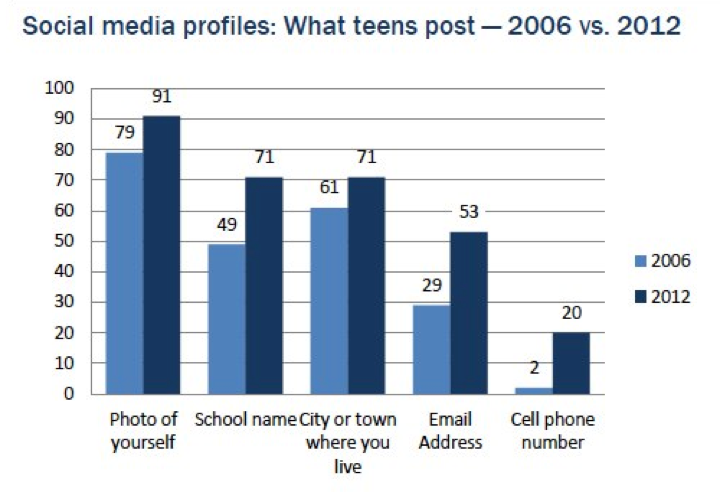How teens use social media and why it matters to you. Generation Z = (Today’s Teens, Preteens and Children)
If you want a glimpse of the future of technology and its impact on society, study how younger generations interact with one another today. While everyone is talking about Millennials these days, there’s another, potential more disruptive generation behind them…Generation Z.
With the sting of a face palm, you’ll experience a sheer rush of humility as you realize that everything you thought you knew about tech, behavior, and common sense is simply nascent compared to the native differences inherent to digital natives. No matter how connected you are or how many followers or friends you have online, there’s a sense of artistry mashed together with counter intuitive behavior that just works.
My advice to you is to study it. Study it right.now. Don’t try to make sense oft it. Don’t question it. Don’t try to make it fit into your world. Simply try to understand it. Doing so opens the door to alternative perspectives, which can lead to meaningful insights. And, this allows you to make decisions about the future without letting your predispositions or assumptions lead you in fallacious directions.
The point is this, for those that need a TL;DR version…perspective and empathy allow you to appreciate and lead not only for Gen Y and Gen Z but also everything that’s changing in between. It’s about leading through resilience.
To help Pew Research Center published an interesting study that examines teens’ social media privacy management and overall behavior. Why is it important? Well, for starters, social and mobile for teens (aka digital natives) is simply a way of life.
A Crazy Little Thing Called Privacy
If you think about it, Generation X and to some extent the older side of Generation Y, are the last to know privacy as it was. Privacy for the most part is something that older generations guarded. For most, privacy was and is sacred, worthy of protecting. Publicity on the other hand was almost a luxury. To earn the attention of the masses required investment and strategy. It’s almost the opposite is true among digital natives. Privacy now is something that you have to teach or learn the hard way.
According to Pew, teens share more information about themselves on social media than ever before.
91% post a photo of themselves, up from 79% in 2006.
71% post their school name, up from 49%.
71% post the city or town where they live, up from 61%.
53% post their email address, up from 29%.
20% post their cell phone number, up from 2%.
While the top three aren’t necessarily jaw dropping, we start to see the erosion of privacy and the rise of publicness with the jump in sharing phone numbers publicly. And this is only the beginning.
Pew Data Visualized: Source: MarktingLand (Imagine what this will look like in 2014 and 2015!!!)
Once regulated to closed networks and dedicated communities for school, work, dating, etc. personal information is now finding its way into public spaces such as Facebook, Twitter, et al.
92% of teens post their real name to the profile they use most often.
84% post their interests, such as movies, music, or books they like.
82% post their birth date.
62% post their relationship status.
24% post videos of themselves.
Privacy takes on an entirely new meaning now. While much of social and mobile is often studied through the lens of what people say and share and what they don’t, it’s also tied to movement (GPS), transactional data, and specific locations. In fact, Pew learned that 16% of teens have set up their social profiles to automatically include their location in posts. Doing so sends a passport-like signal to their friends (and for themselves_ about where they’ve visited combined with a sense of serendipity to also see (and meet) who’s nearby.
A Private Facebook vs. A Public Twitter
94% of all teens who use social media have a profile on Facebook. Twitter’s rising fast. 26% of teens manage a profile on Twitter, which is up from 12% just one year earlier.
On Facebook, ironically enough, teens tend to choose a myriad of privacy settings. 60% keep their profiles private and most believe that they are in control of their privacy settings. They also go through hoops to support multiple accounts to engage on respective fronts accordingly. They also go to great lengths to delete older posts to prevent the risk of future drama.
With Twitter on the other hand, 64% of teens choose a public profile and 12%, believe it or not, are not sure whether or not their public tweets are private or public.
The Brand “You”
Teens, in their own way, manage their Facebook presence to portray their desired persona while masking information they don’t want others to know or learn.
On Facebook, teens host a network of 300 friends on average. On the more public Twitter front, average teen users have about 79 followers. This comes down to an important distinction about the value and focus of each network. Facebook is designed to help people connect and communicate to their social graph. With Twitter, it’s all about the interest graph. People tend to follow others who share interests or channels that are informative and entertaining, not unlike a traditional broadcast network.
The Age of the Selfie and The Rise of Accidental Narcissism
What’s not included in this study is how teens use Tumblr, Instagram and Snapchat. This is a critical element missing from the study. While an overwhelming majority of teens use or have Facebook accounts, teens, and millennials in general, are spending significant portions of time and attention in other networks such as Tumblr (a social network for micro content), Instagram (a social network for pictures) and Youtube (a social network for video), SnapChat ( a network for self-destructing pictures). See the pattern?
Why?
In an interview with AP, Jaime Esquivel, a 16-year-old junior at C.D. Hylton High School in Woodbridge, Va., shared a truism that I’ve heard repeatedly among teens over the years, “Facebook just really seems to have more drama.”
But it’s more than that. Other networks seem to focus on curated content and also self-expression.
Instagram is not just a camera app, although many younger kids fooled their parents by convincing them that it was a camera app. Instead, it’s a full blown social network where pictures of the catalysts for conversations and Likes and followers are the currency of shallow capitalism. Instagram is harboring curious behavior where teens strive for numbers, regardless of where and who they come from, as a delusional form of stature and importance.
In a study in Photo District News, author Kathleen Hay shared some sobering stats on the rise selfie-expression.
At 11 p.m. PST on December 28, 2012, the number of selfies numbered at a noteworthy 5.5 million. At the same time, photos tagged ‘me’ completely eclipsed “selfie” with a staggering 72.6 million self-portraits. Added together, you start to get the picture of just how prominent the egosystem is becoming.
Privacy as we once knew it is dead. It’s now a part of real and digital life that necessitates education and ongoing study. Parents, teachers, mentors, role models, take note. Pleading ignorance is not an excuse.
For adults, privacy’s meaning is also shifting. To evolve, a new school of philosophy and overall strategy is essential as we use the same apps, networks, and devices that younger generations use to broadcast their social life. The line that divides online and offline character and image is rapidly, and intentionally, eroding. And for some, it’s completely vanished.
In many ways, we are all exhibiting behaviors that aren’t unlike teens, regardless of age. The truth is that we live in an era of increasing connectedness and we are all becoming part of one larger generation, Generation-C (connected.)
Welcome to the new age.
Connect with me…
Twitter | LinkedIn | Facebook | Google+ |Youtube | Instagram | Pinterest
Photo of Teenagers, Shutterstock








I have two daughters; one is 13, the other will be 11 in four months. I am a big advocate of openly using social media and take a position on privacy somewhere between “here I am” and “let me shove this info down your digital throat”. I am 67 years old. I would love to learn from my oldest, but I’ve clearly morphed from “Daddy” to “the weird old dude who quite unfortunately lives in the same house I do, but has a car.” I asked her if, now that she’s old enough to have a Facebook account, she was going to get one. She did not seem terribly enthusiastic. Despite these handicaps, I’m watching closely. There is, indeed, much to learn.
Thank you for sharing Rick!
“Wisdom comes from having multiple perspectives.” Gregory Bateson
This piece reminds me of this quote Brian. It also reminds me of the four positions in which you can gain new perspectives . . .
You can get multiple perspectives from published information or directly from people.
—–> So first person position is you looking at another person from your perspective.
—–> Second person position is putting yourself in another person’s body/model of the world
and seeing yourself as they see you. This where the value of coaching is – getting another person’s perspective on how they see you.
In your mind a good question to ask is, “What would I look like from another person’s perspective?”
A good teacher, marketer, advertiser, etc. should ask themselves the question, “What do I look like from my audience’s perspective?” This is called going to second position. And you can do this with multiple people thus gaining wisdom from multiple perspectives.
The key with going to second position is having a great understanding of the
other person’s model of the world.
—–> The next position is that of an observer.
This would be you watching you having an interaction with another person. The powerful way to boost the potency of this is to introduce the element of time. You look at how what you do affects another person and how what the other person does affects you.
—–> The next position is that of leaving a person out and inserting an environment. You ask how are you impacting this environment and how is the environment affecting you.
So in the instance of seeking to influence in a sales situation, you’d first see yourself trying to close a prospect. Then you’d look at you from the prospect’s position. Then you go above and watch the interaction between you and the other person. It has amazed Wyatt Woodsmall, the person I learned this from, how when marketers and sales persons can go meta-meta like this, how their results skyrocket.
When a person can take on these perspectives, you can go beyond “Blunt Force Trauma – Give Me The Money NOW” marketing and advertising . . . or abstract, vague, and boring marketing and advertising to something I like to think of as “Meaningful Marketing” – meaningful messages that connect with your perfect prospect.
I just read this post titled “The Top 20 Most Shared Ads For June 2014, here http://www.reelseo.com/video-ads-shared-jun-2014/ and I would say that a common theme among some of the best of them is that they sought not to simply talk about how cool they are but to get inside the perspective of the person they would like to serve.
And as a result, these persons spread their message far and wide.
I’d like to thank you Brian for reminding me that if I’m going to make meaningful marketing, I have to get out of this shell of mine and truly seek to see the world through my perfect prospects eyes and speak to what matters most to them.
I love this comment Lewis. Thank you. I’m going to point people directly to it as a point of promoting the conversation beyond the post.
Thanks for sharing this Brian.
I really like how you encourage people to study it so that they can understand this generation’s perspective. I was white water rafting with a group of gentlemen in their 60’s last week, and they couldn’t grasp social media. I used the same explanation as you.
I had an epiphany about a year ago regarding communication. At the time I was struggling staying connected to my younger sisters (highschool level). Phone call, and emails were prehistoric…and Facebook yielded marginal results.
My solution? I downloaded Snapchat. Suddenly I was receiving daily correspondence with my little sisters. I realized that each generation has a preferred method of communication. Older folks prefer good old face to face, or at the very least a phone call. I prefer Facebook. My sister’s prefer Snapchat. Have you noticed this before?
Another interesting thing to add to this article is why teens are moving to more mobile networks (like Snapchat). One explanation is that they have access to iPods and other mobile devices that allow them to connect to the web (even when their parents are unaware).
Recognizing this trend is critical for marketers because it means that the next trend of marketing/products will need to be focused on mobile.
Josh
Wonderful comment Josh. Thank you for sharing your story.
Cheers!
I agree it’s a miss not to cover Instagram, Tumblr and Snapchat. Snapchat is curious to me as both a marketer and parent.
I’m also seeing Google+ emerge among the younger teens whose parents are leery of ‘social media’. I don’t think many realize that if you have a gmail account, which many teens do as a result of parents thinking email is ‘safe’, you also have a Google+. Hangouts are very common, which is more open that any of the social sites listed above.
I’ll be watching all of this very closely. Thanks for a great post. I’ll be sharing both ‘socially’ via Facebook and ‘professionally’ via LinkedIn. Although my connections in both platforms have dramatic overlapping.
I love this and think I love you!! ha! I have been following this social media morph from when my son was in 6th grade, now he’s going in to 9th and you could not be more spot on. I think parents of this generation need to wake up and get with the program. Knowledge is power, and the fact of the matter is there are still creepers out there who are thrilled at this generations desire to share so freely. Be aware, have conversations, don’t dictate, rather discuss, know these apps, use them, be relevant to your child so that you can help them navigate the way. Thanks Brian for the article…you have gained a follower in me!
Thank you for making my day Tabitha!
Neat article! Just buffered it for posting this Monday 😉
There’s a presentation from Dylan Collins, CEO of SuperAwesome, at GameHorizon, about the behavior of children on YouTube and chat messengers, that I think you’ll find interesting:
https://www.youtube.com/watch?v=fBZYkRv5jMw
(about 20 minutes long)
It kinda confirmed a hunch and led me to write this quick blurb about the need for connected brands to get onto WhatsApp, SnapChat and the Asian pendants, in order to stay in touch with kids and teens:
https://www.linkedin.com/today/post/article/20140626175541-45722420-time-for-customer-support-over-whatsapp
Connected is the things as we’ve talked about before, I love you too just thought I better say that as Tabitha may have started something. While everyone else pukes, i did it for that reason.
The reason those so young do what they do, same as we did when that age – LIFE. They grab it and throw it around and make sense of it for them not some old guy who stand on a stage and people pay to hear what he has to say and then go and try to make that work for them. Your not that old Brian I know 🙂
So if they can have fun and enjoy the techie stuff and make better videos than a load of design agencies, why are so many brands unable to get it?
Possibly becasue they need a spreadsheet to figure it out, or a stat.
What we need to do as you point toward so well is understand them whoever they are that are important to us. These people are the future and they’re enjoying the here and now too.
So many brands mess up the here and now trying to be cool, far better to LIVE and be creative while living, which doesn’t mean creating art it could be anything. Everyone else is creative it’s time for brands to get their heads out of the sand and do it too.
Creating things that cause emotive reactions is just the start…….